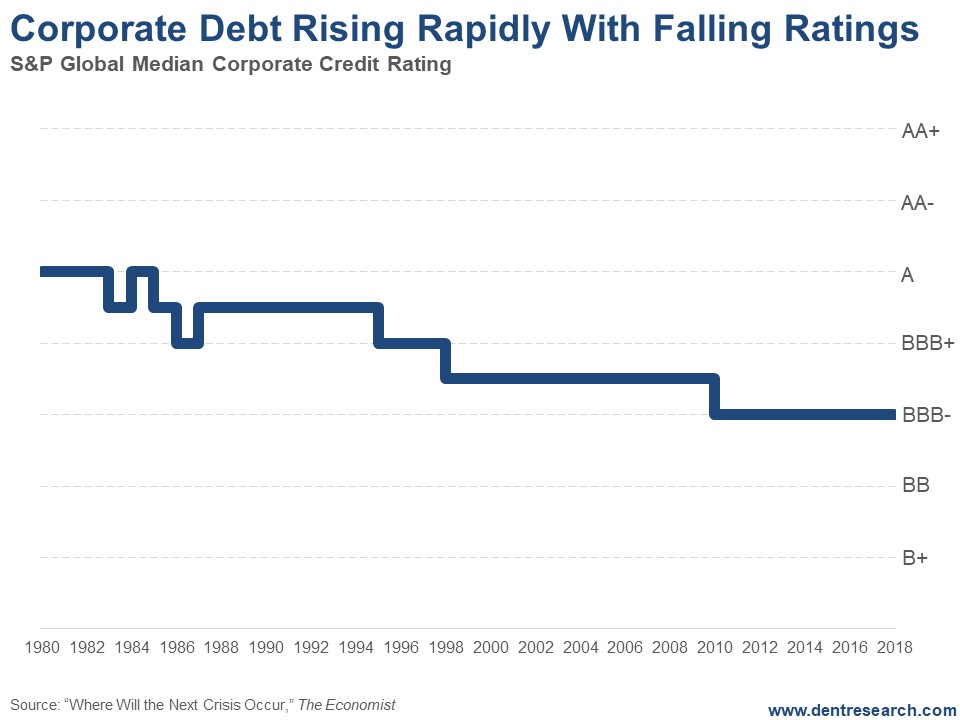Two big news items in the last 24 hours have grabbed my attention.
The first is Congress’s approving a bill to roll back the Dodd-Frank Act. If this passes, smaller financial institutions will find relief from the strict rules that have applied to Wall Street banks since after the 2008 crisis.
This is sheer idiocy! It will not end well.
The second is the U.S. corporate debt is suffering one of its worst sell-offs since 2000. This is another disaster in the making.
U.S. corporate debt has risen from $40 trillion to $70 trillion since the top of the last bubble in 2007. That’s 63% in 10 years. It’s risen 135% since 2000!
Only government debt has risen faster, from $35 to $64 trillion, or 83%.
China is the worst by far, going from $6 to $36 trillion or a 500% increase!
Of course, many of these bonds are simply financial engineering to buy back stock to increase earnings per share. Uber-low long-term interest rates thanks to QE have allowed companies to do this cheaply.
The problem is these long-term rates have been rising since just July 2016. They’ve gone from 1.38% to 3.10%. That’s an increase of 172 basis points in the risk-free 10-year Treasury bond. That naturally reverberates up through the risk spectrum from investment grade corporate bonds to junk bonds.
You see, here’s the thing…
Governments have artificially pushed down bond yields for so long that companies have embraced speculation rather than productive investment (i.e. they’re not spending money on productive assets that will serve them and the economy well in the long-term).
This mentality only creates financial asset bubbles that burst.
When companies buy back their own shares at historically high valuations, they’re speculating, just like an investor or hedge fund.
When stocks crash ahead, shareholders will demand to know why these corporations used the money they will need to survive the crisis to speculate in their own stock… at the highest prices in history!
Well, as the numbers are now showing, this corporate bond bubble is starting to burst, and of course that will ultimately hit junk bonds the worst… then stocks and real estate.
But the real story here is that we’ve been in this bond bubble since 1981. And the quality of this corporate debt has been falling for nearly 40 years now. QE has only accelerated the decline.
We’re now at the point where the median corporate bond rating is borderline junk…
Median ratings started at A in the early 1980s when this unprecedented boom began. Since then, it has steadily fallen to BBB-. The next step down is junk bonds.
And this is a global phenomenon. It’s not just isolated to U.S. corporations.
Forty-eight percent of investment grade bonds are rated BBB, just one notch above the median in this chart. The net leverage ratio for such BBB issuers has gone up from 1.7 in 2000 to 2.9 today.
All of this means that investors are getting rewarded less and less for lower quality bonds. Yet such investors are less worried than ever, as shown by a 40% drop in the cost of insuring such bonds (through credit default swaps) in the last two years. Continued tightening by the fed only makes this worse.
This is a bond crash and debt crisis in the making and could end up being the biggest trigger for the stock crash. And it’s already in motion!
The content of our articles is based on what we’ve learned as financial journalists. We do not offer personalized investment advice: you should not base investment decisions solely on what you read here. It’s your money and your responsibility. Our track record is based on hypothetical results and may not reflect the same results as actual trades. Likewise, past performance is no guarantee of future returns. Certain investments such as futures, options, and currency trading carry large potential rewards but also large potential risk. Don’t trade in these markets with money you can’t afford to lose. Delray Publishing LLC expressly forbids its writers from having a financial interest in their own securities or commodities recommendations to readers.
Recommended Content
Editors’ Picks
EUR/USD regains traction, recovers above 1.0700

EUR/USD regained its traction and turned positive on the day above 1.0700 in the American session. The US Dollar struggles to preserve its strength after the data from the US showed that the economy grew at a softer pace than expected in Q1.
GBP/USD returns to 1.2500 area in volatile session

GBP/USD reversed its direction and recovered to 1.2500 after falling to the 1.2450 area earlier in the day. Although markets remain risk-averse, the US Dollar struggles to find demand following the disappointing GDP data.
Gold climbs above $2,340 following earlier drop

Gold fell below $2,320 in the early American session as US yields shot higher after the data showed a significant increase in the US GDP price deflator in Q1. With safe-haven flows dominating the markets, however, XAU/USD reversed its direction and rose above $2,340.
XRP extends its decline, crypto experts comment on Ripple stablecoin and benefits for XRP Ledger

Ripple extends decline to $0.52 on Thursday, wipes out weekly gains. Crypto expert asks Ripple CTO how the stablecoin will benefit the XRP Ledger and native token XRP.
After the US close, it’s the Tokyo CPI

After the US close, it’s the Tokyo CPI, a reliable indicator of the national number and then the BoJ policy announcement. Tokyo CPI ex food and energy in Japan was a rise to 2.90% in March from 2.50%.
